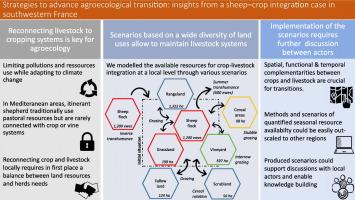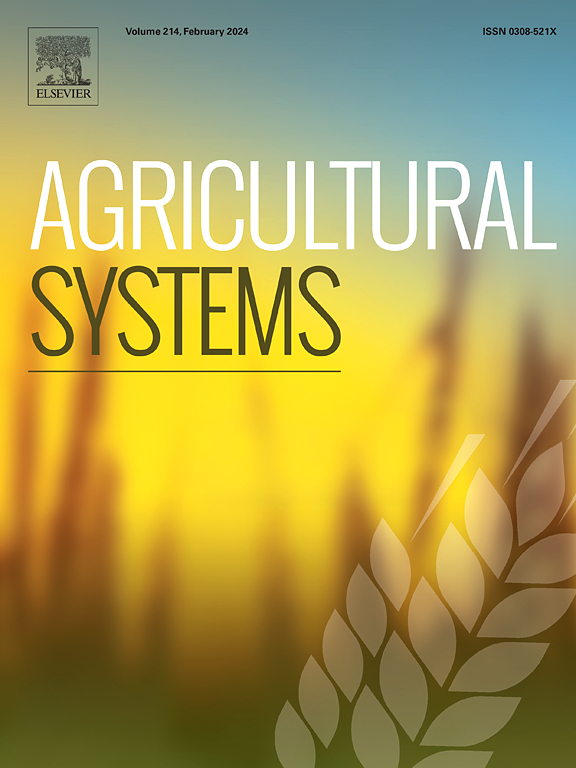推进农业生态转型的策略:来自法国西南部羊-作物整合案例研究的见解
IF 6.1
1区 农林科学
Q1 AGRICULTURE, MULTIDISCIPLINARY
引用次数: 0
摘要
地中海地区面临多重挑战,包括生物多样性丧失、土壤退化和易受气候变化影响。在法国南部的朗格多克地区,葡萄园单一栽培占主导地位,牲畜系统很少。农业生态转型,特别是作物-牲畜一体化,为实现系统多样化、养分循环、增强生物多样性和减少火灾风险提供了机会。然而,由于气候限制、土地可及性以及目前作物和牲畜系统之间的脱节,这种整合是困难的。目的本研究旨在探讨如何扩大Minervois地区的作物-牲畜一体化实践,以支持农业生态转型。它侧重于确定协同效应,以满足当地羊群的饲料需求,并为葡萄园和谷物种植者创造利益。方法基于更广泛的参与性和立足当地的方法,我们设计了基于绵羊养殖系统与各种作物和半自然区域整合的农业生态场景。我们评估了在最近很少有系统存在的地区重新引入牲畜的潜力。该进程确定了全年用当地饲料维持牲畜所需的生物技术和协调条件,并组织了利益攸关方之间的交流。结果与结论除干旱条件外,通过谷物作物、葡萄园行间、当地牧场和跨牧(即将羊群从一个地区转移到另一个地区,以利用可用的饲料资源)的多样化景观,可以全年维持1200只母羊的羊群。这种多样性通过利用动物和植物物种之间随时间和空间的协同作用,实现作物与牲畜的互补性,从而提高农业生态绩效。所使用的方法可以适用于其他地区,利益相关者的参与对于发展理解和实施可行的场景至关重要。研究结果支持未来的研究,旨在将饲料供应与组织战略联系起来,以确定放牧区域并制定具体的实施计划。本文章由计算机程序翻译,如有差异,请以英文原文为准。

Strategies to advance the agroecological transition: Insights from a case study of sheep–crop integration in southwestern France
Context
Mediterranean areas face multiple challenges, including biodiversity loss, soil degradation, and vulnerability to climate change. In southern France's Languedoc region, vineyard monoculture dominates, and livestock systems are rare. Agroecological transitions, especially crop-livestock integration, offer opportunities to diversify systems, recycle nutrients, enhance biodiversity, and reduce fire risks. However, such integration is difficult due to climatic constraints, land accessibility, and the current disconnection between crop and livestock systems.
Objective
This study aimed to explore how crop-livestock integration practices in the Minervois territory could be expanded to support agroecological transitions. It focused on identifying synergies that address forage needs for local flocks and create benefits for vineyard and cereal farmers.
Methods
As part of a larger participatory and locally grounded approach, we designed agroecological scenarios based on integration of sheep farming system with various crop and semi-natural areas. We assessed the potential to reintroduce livestock in an area where few systems have existed recently. The process identified both the biotechnical and coordination conditions required to sustain livestock with local forage throughout the year and to organize exchanges among stakeholders.
Results and conclusions
Except under dry conditions, a flock of 1200 ewes could be sustained year-round through a diversified landscape combining cereal crops, vineyard inter-rows, local rangelands, and transhumance (i.e., moving the flock from one territory to another to graze available forage resources). This diversity enhances agroecological performance through crop-livestock complementarities by exploiting synergies between animal and plant species, over time and space. The method used can be adapted to other territories, and stakeholder involvement is essential for developing understanding and implementing feasible scenarios
Significance
The results support future studies aiming to link forage availability with organizational strategies to identify grazing areas and develop concrete implementation plans.
求助全文
通过发布文献求助,成功后即可免费获取论文全文。
去求助
来源期刊

Agricultural Systems
农林科学-农业综合
CiteScore
13.30
自引率
7.60%
发文量
174
审稿时长
30 days
期刊介绍:
Agricultural Systems is an international journal that deals with interactions - among the components of agricultural systems, among hierarchical levels of agricultural systems, between agricultural and other land use systems, and between agricultural systems and their natural, social and economic environments.
The scope includes the development and application of systems analysis methodologies in the following areas:
Systems approaches in the sustainable intensification of agriculture; pathways for sustainable intensification; crop-livestock integration; farm-level resource allocation; quantification of benefits and trade-offs at farm to landscape levels; integrative, participatory and dynamic modelling approaches for qualitative and quantitative assessments of agricultural systems and decision making;
The interactions between agricultural and non-agricultural landscapes; the multiple services of agricultural systems; food security and the environment;
Global change and adaptation science; transformational adaptations as driven by changes in climate, policy, values and attitudes influencing the design of farming systems;
Development and application of farming systems design tools and methods for impact, scenario and case study analysis; managing the complexities of dynamic agricultural systems; innovation systems and multi stakeholder arrangements that support or promote change and (or) inform policy decisions.
 求助内容:
求助内容: 应助结果提醒方式:
应助结果提醒方式:


